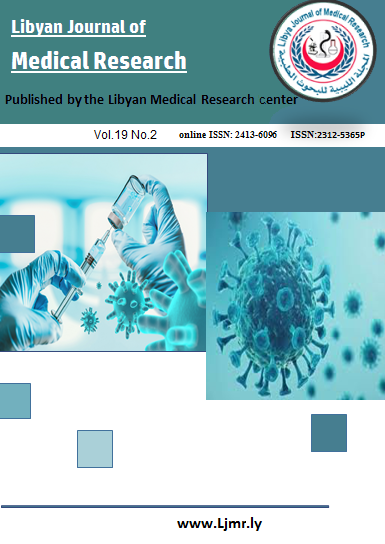Survey on Drug–Drug Interactions and Medicine Use in Hospitalized Patients
DOI:
https://doi.org/10.54361/LJMR.19.2.32Keywords:
Drug-Drug Interactions, Hospitalized Patients, Medication Use, Patient Awareness, LibyaAbstract
Background: Drug-drug interactions (DDIs) are a significant concern in hospitalized patients, as they can compromise treatment effectiveness and patient safety. Limited data exist regarding the prevalence, patterns, and awareness of DDIs in Libyan healthcare settings, where both hospital and private clinic patients often receive multiple medications, including prescription, over-the-counter, and herbal remedies. Understanding these patterns is essential for optimizing pharmacotherapy and preventing adverse outcomes. Aim of the study: This study aimed to investigate the prevalence of DDIs and patterns of medicine use among hospitalized patients in Libyan hospitals and private clinics, while also assessing patient awareness and attitudes toward DDIs. Material and Methods: A cross-sectional study was conducted from March to May 2025. Adult patients (≥18 years) admitted for at least 24 hours and prescribed two or more medications were included. Data were collected from medical records and prescribing charts and entered into SPSS version 26.0. Potential DDIs were identified using validated screening tools. Descriptive statistics, including frequencies and percentages, were applied to analyze demographic characteristics, medication use patterns, and awareness levels. Results: The study revealed a heterogeneous patient demographic, with widespread use of prescription, over-the-counter, and herbal medications. Awareness of DDIs was moderate (50%), yet 55% of patients believed that combining medicines could be harmful. Reported adverse effects due to drug combinations were noted by 52% of participants. Medication disclosure to healthcare providers was inconsistent, with only 36% always informing, 35% sometimes, and 29% never disclosing their use of additional medicines. Importantly, 57% of patients expressed a desire for more information about DDIs. Conclusion: This study offers foundational insights into the prevalence and awareness of DDI among hospitalized patients in Libya. The results emphasize the urgent need for enhanced medication safety strategies, including patient education, routine DDI screening, and strengthened patient-provider communication. Future research should focus on identifying specific DDI types, evaluating their clinical impact, and testing the effectiveness of preventive interventions to optimize pharmacotherapy and improve patient outcomes.
Downloads
References
1. Li L, Baker J, Quirk R, Deidun D, Moran M, Salem AA, Aryal N, Van Dort BA, Zheng WY, Hargreaves A, Doherty P. Drug–Drug Interactions and Actual Harm to Hospitalized Patients: A Multicentre Study Examining the Prevalence Pre-and Post-Electronic Medication System Implementation. Drug safety. 2024 Jun;47(6):557-69.
2. Mousavi S, Ghanbari G. Potential drug-drug interactions among hospitalized patients in a developing country. Caspian journal of internal medicine. 2017;8(4):282.
3. Bucşa C, Farcaş A, Cazacu I, Leucuta D, Achimas-Cadariu A, Mogosan C, Bojita M. How many potential drug–drug interactions cause adverse drug reactions in hospitalized patients?. European journal of internal medicine. 2013 Jan 1;24(1):27-33.
4. Bojuwoye, Adetola Olaniyi; Suleman, Fatima; PERUMAL-PILLAY, Velisha Ann. Polypharmacy and the occurrence of potential drug–drug interactions among geriatric patients at the outpatient pharmacy department of a regional hospital in Durban, South Africa. Journal of pharmaceutical policy and practice, 2022, 15.1: 1.
5. Gonzaga de Andrade Santos TN, Mendonça da Cruz Macieira G, Cardoso Sodré Alves BM, Onozato T, Cunha Cardoso G, Ferreira Nascimento MT, Saquete Martins-Filho PR, Pereira de Lyra Jr D, Oliveira Filho AD. Prevalence of clinically manifested drug interactions in hospitalized patients: A systematic review and meta-analysis. PloS one. 2020 Jul 1;15(7):e0235353.
6. Shareef J, Sridhar SB, Ismail AN, Rao PG, Ur RA. Assessment of potential drug-drug interactions in hospitalized patients with infectious diseases: an experience from a secondary care hospital. F1000Research. 2025 Jan 2;13:164.
7. Aksoy N, Ozturk N. A meta‐analysis assessing the prevalence of drug–drug interactions among hospitalized patients. Pharmacoepidemiology and drug safety. 2023 Dec;32(12):1319-30.
8. Zheng WY, Richardson LC, Li L, Day RO, Westbrook JI, Baysari MT. Drug-drug interactions and their harmful effects in hospitalised patients: a systematic review and meta-analysis. European journal of clinical pharmacology. 2018 Jan;74(1):15-27.
9. Watanabe JH, Kwon J, Nan B, Abeles SR, Jia S, Mehta SR. Medication use patterns in hospitalized patients with COVID-19 in California during the pandemic. JAMA Network Open. 2021 May 3;4(5):e2110775-.
10. Walraven B, Ponjee G, Heideman W, Çarkit FK. Medication reviews in hospitalized patients: a qualitative study on perceptions of primary and secondary care providers on interprofessional collaboration. BMC Health Services Research. 2020 Sep 29;20(1):902.
11. Makiani, Mahin Jamshidi, et al. Drug-drug interactions: The importance of medication reconciliation. Journal of research in pharmacy practice, 2017, 6.1: 61-62.
12. Aksoy N, Ozturk N. A meta‐analysis assessing the prevalence of drug–drug interactions among hospitalized patients. Pharmacoepidemiology and drug safety. 2023 Dec;32(12):1319-30.
13. Barnsteiner JH. Medication reconciliation. Patient safety and quality: an evidence-based handbook for nurses. 2008 Apr.
14. Hammar T, Hamqvist S, Zetterholm M, Jokela P, Ferati M. Current knowledge about providing drug–drug interaction services for patients—a scoping review. Pharmacy. 2021 Mar 24;9(2):69.
15. Peabody J, Schrecker J, Heltsley R, Paculdo D, de Belen E, Tamondong-Lachica D, Acelajado MC, Ouenes O, Kennedy T, Jeter E. Randomized Trial to Improve Primary Care Patient Management and Patient Outcomes Using a Drug–Drug Interaction Test: Confirmation of the DECART Simulated Patient Clinical Utility Trial Results. Diagnostics. 2021 Jul 15;11(7):1266.
16. Bucşa C, Farcaş A, Cazacu I, Leucuta D, Achimas-Cadariu A, Mogosan C, Bojita M. How many potential drug–drug interactions cause adverse drug reactions in hospitalized patients?. European journal of internal medicine. 2013 Jan 1;24(1):27-33.
17. Targeted Medication Safety Best Practices for Hospitals - ECRI. URL: https://home.ecri.org/blogs/ismp-resources/targeted-medication-safety-best-practices-for-hospitals.
18. Tariq RA, Vashisht R, Sinha A, Scherbak Y. Medication dispensing errors and prevention.
19. Institute for Safe Medication Practices (ISMP). ISMP targeted medication safety best practices for hospitals.
Downloads
Published
Issue
Section
License
Copyright (c) 2025 Ebtesam A. Beshna, Fadhil A. ALshareef (Author)

This work is licensed under a Creative Commons Attribution-NonCommercial-NoDerivatives 4.0 International License.
Open Access Policy
Libyan journal of medical Research (LJMR).is an open journal, therefore there are no fees required for downloading any publication from the journal website by authors, readers, and institution.
The journal applies the license of CC BY (a Creative Commons Attribution 4.0 International license). This license allows authors to keep ownership f the copyright of their papers. But this license permits any user to download , print out, extract, reuse, archive, and distribute the article, so long as appropriate credit is given to the authors and the source of the work.
The license ensures that the article will be available as widely as possible and that the article can be included in any scientific archive.
Editorial Policy
The publication of an article in a peer reviewed journal is an essential model for Libyan journal of medical Research (LJMR). It is necessary to agree upon standards of expected ethical behavior for all parties involved in the act of publishing: the author, the journal editorial, the peer reviewer and the publisher.
Any manuscript or substantial parts of it, submitted to the journal must not be under consideration by any other journal. In general, the manuscript should not have already been published in any journal or other citable form, although it may have been deposited on a preprint server. Authors are required to ensure that no material submitted as part of a manuscript infringes existing copyrights, or the rights of a third party.
Authorship Policy
The manuscript authorship should be limited to those who have made a significant contribution and intellectual input to the research submitted to the journal, including design, performance, interpretation of the reported study, and writing the manuscript. All those who have made significant contributions should be listed as co-authors.
Others who have participated in certain substantive aspects of the manuscript but without intellectual input should only be recognized in the acknowledgements section of the manuscript. Also, one of the authors should be selected as the corresponding author to communicate with the journal and approve the final version of the manuscript for publication in the LJMR.
Peer-review Policy
- All the manuscripts submitted to LJMR will be subjected to the double-blinded peer-review process;
- The manuscript will be reviewed by two suitable experts in the respective subject area.
- Reports of all the reviewers will be considered while deciding on acceptance/revision or rejection of a manuscript.
- Editor-In-Chief will make the final decision, based on the reviewer’s comments.
- Editor-In-Chief can ask one or more advisory board members for their suggestions upon a manuscript, before making the final decision.
- Associate editor and review editors provide administrative support to maintain the integrity of the peer-review process.
- In case, authors challenge the editor’s negative decision with suitable arguments, the manuscript can be sent to one more reviewer and the final decision will be made based upon his recommendations.














